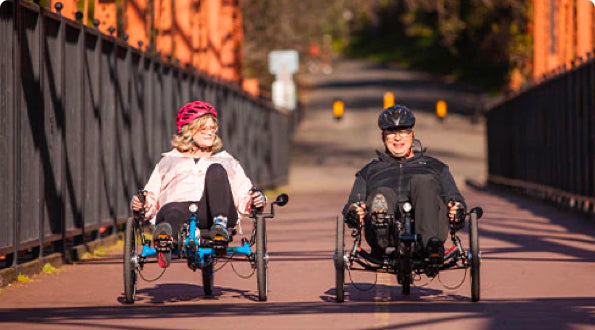April 09, 2024
For decades, traditional bicycles have dominated the cycling scene. However, in recent years, a compelling alternative has emerged—the recumbent bicycle. Whether you're an experienced cyclist seeking a fresh perspective or a newcomer eager to explore new biking horizons, recumbent bicycles present an intriguing departure from the norm. But what makes them worth considering? In this article, we'll explore the realm of recumbent bicycles, unveiling their distinctive advantages.
In This Article:
What Is A Recumbent Bicycle? [Dispelling Common Confusion]
Why Recumbent Bicycles Are Gaining Speed on Stationary Recumbent Exercise Bikes
The Advantages of Recumbent Bikes
The Disadvantages of Recumbent Bikes
Top 7 Recumbent Bicycle Brands
What Is A Recumbent Bicycle? [Dispelling Common Confusion]
We all know what a bicycle is right? Great. Let’s start with “recumbent”.
"Recumbent" is an adjective that describes a position of reclining or lying down. In the context of bicycles or exercise equipment, "recumbent" typically refers to a design where the rider is seated in a reclined position with their legs positioned in front of them rather than beneath them as in traditional upright bicycles. Recumbent bicycles and exercise bikes are designed to allow the rider to pedal while in this reclined position, offering a more comfortable riding or exercising experience compared to upright models.
“Recumbent Bike” is a term that can mean different things to different people. To one, it may mean the bike they ride to work each day in comfort. To others, it may be the machine that sits in the corner of their living room. And to others, it’s actually a recumbent tricycle they’re referring to. That gives us three distinct meanings of “recumbent bike”.
1. Stationary Recumbent Exercise Bike
This type of recumbent bike is stationary, meaning it doesn't move from its position. It's primarily designed for indoor use, often found in gyms or home fitness setups.
The user sits in a reclined position with their legs positioned in front of them to pedal.
Stationary recumbent exercise bikes are focused solely on providing cardiovascular exercise and are not suitable for outdoor riding
2. Two-Wheel Recumbent Bicycle
This is a recumbent bicycle that typically has two wheels, similar to a traditional bicycle but with a different seating position.
The rider sits in a reclined position with their legs extended forward to reach the pedals.
Two-wheel recumbent bicycles are typically used by cyclists that converted due to comfort.
They offer a different riding experience compared to upright bicycles, with some riders finding them more comfortable due to the ergonomic seating position.
3. Recumbent Tricycle
A recumbent tricycle, sometimes also referred to as a recumbent bike, features three wheels instead of two.
Like the two-wheel recumbent bicycle, the rider sits in a reclined position, but with the stability provided by the third wheel.
Recumbent tricycles offer stability compared to unstable two-wheel recumbent bicycles, making them suitable for riders who may have concerns about balance or those who prefer a more stable ride.
These tricycles are also primarily designed for outdoor use and can be used for leisure riding, commuting, or touring.
If you did a search on the internet 10 years ago versus today, the results for “recumbent bike” would be much different. With the rising popularity of recumbent tricycles, the meaning of the term is being questioned.
Though stationary recumbent bikes currently sell the most units per year in the US, the recumbent tricycle has already passed the recumbent two-wheeler and is coming for the stationary recumbent. An aging population is creating the demand for a comfortable way to cycle that doesn’t require staring at a blank wall (*ahem* we’re looking at you, stationary recumbent).
Why Recumbent Bikes Are Gaining Speed on Stationary Recumbent Exercise Bikes
So why is the recumbent bike industry growing more than the stationary recumbent market?
The Outdoor Riding Experience: Recumbent bikes allow riders to enjoy the outdoors, experiencing fresh air, scenery, and the freedom of riding on roads or bike paths. This outdoor experience is far more enjoyable and stimulating compared to exercising indoors on a stationary bike.
Fresh Air
Beautiful Nature
Variety of Terrain
Social Interactions
More Fun = More Exercise
The Advantages of Recumbent Bikes
Recumbent bikes offer several advantages over traditional bicycles and stationary bikes, including:
Stability
With three wheels instead of two, recumbent tricycles provide enhanced stability, making them suitable for riders who may have balance issues or those who are uncomfortable riding on two wheels. This stability can instill confidence in riders, especially older adults or individuals with physical limitations. A third wheel enables the recumbent riding position without the high instability of a two-wheel recumbent.
Comfort
Recumbent bikes feature a reclined seating position that distributes the rider's weight over a larger area, reducing pressure on the back, neck, and wrists. The ergonomic design can alleviate discomfort commonly experienced with traditional upright bicycles, making recumbents more comfortable for long rides.
Safety
The stability of recumbent bikes reduces the risk of tipping over, particularly when coming to a stop or navigating tight turns. Motorists generally give recumbent riders a wider birth on the road than traditional bicyclists due to their wider and ‘uncommon’ nature.
Accessibility
Recumbent bikes are accessible to a wide range of individuals, including those with mobility impairments, balance issues, or neurological conditions – and simply easier for the everyday cyclist. The design and stable platform make it easier for riders to mount and dismount the tricycle, regardless of physical ability.
Cargo Capacity
Many recumbent bikes come equipped with storage options, such as baskets or rack, allowing riders to carry groceries, supplies, or personal belongings conveniently. The added cargo capacity makes recumbent bikes practical for errands, commuting, or recreational outings.
Visibility
The reclined seating position of recumbents offers excellent visibility to riders, allowing them to see the road ahead without straining their necks. This enhanced visibility can improve safety by increasing awareness of surrounding traffic and potential hazards.
Low-Impact Exercise
Like traditional bicycles, recumbent bicycles provide a low-impact form of exercise that promotes cardiovascular health, strengthens muscles, and improves joint mobility. The ergonomic design of recumbents reduces stress on the joints, making them suitable for individuals with arthritis or joint pain.
The Disadvantages of Recumbent Bikes
While recumbent bikes offer several advantages, they also have some potential disadvantages to consider:
Wider Turns
Recumbents typically have a larger turning radius compared to traditional bicycles, making them less maneuverable, especially in tight spaces. This can be a drawback when navigating sharp corners or congested areas.
Size and Weight
Recumbent tricycles are generally larger and heavier than traditional bicycles due to the additional wheel and frame structure. This can make them more challenging to transport and store, but there are many transportation and storage solutions available.
Speed
While recumbent bikes can be efficient for cruising and leisurely rides, they may not offer the same level of speed or agility as traditional bicycles, particularly on flat terrain or during sprints. The reclined seating position and aerodynamic profile of recumbents can limit the rider's ability to generate high speeds, which may be a consideration for competitive cyclists or those seeking a faster ride.
Cost
Recumbent bikes can be more expensive than traditional bicycles due to their specialized design, components, and manufacturing processes. The initial investment required to purchase a recumbent may be higher, but the value heavily outweighs the cost.
Adaptation Period
Transitioning from riding a traditional bicycle to a recumbent bike may require an adjustment period for riders to become accustomed to the different handling, seating position, and riding dynamics.
While these disadvantages are worth understanding, for most they do not outweigh the benefits of riding a recumbent bike. Ultimately, the suitability of a recumbent bicycle depends on the rider's preferences, needs, and intended use.
Top 7 Recumbent Bicycle Brands
These are the top brands that sell recumbent bikes based on sales volume and product quality:
Catrike
TerraTrike
ICE
GreenSpeed
SunSeeker
Azub
HP Velotechnik
Note: You could get a stationary bike, which some would consider quite affordable compared to some recumbent bikes. But, in our experience, the stationary bike ends up being a very expensive piece of plastic in the corner of your living room.
While each option has its advantages and disadvantages, the decision ultimately boils down to personal preferences, fitness goals, and intended use. Whether you prioritize comfort, stability, speed, or cargo capacity, there's a recumbent bike option to suit your needs.
Regardless of which type of recumbent bike you choose, one thing is certain: cycling offers numerous health benefits, from improving cardiovascular fitness to strengthening muscles and joints. So whether you're pedaling indoors or cruising the open road, embrace the joy of cycling and embark on a journey towards better health and well-being.










